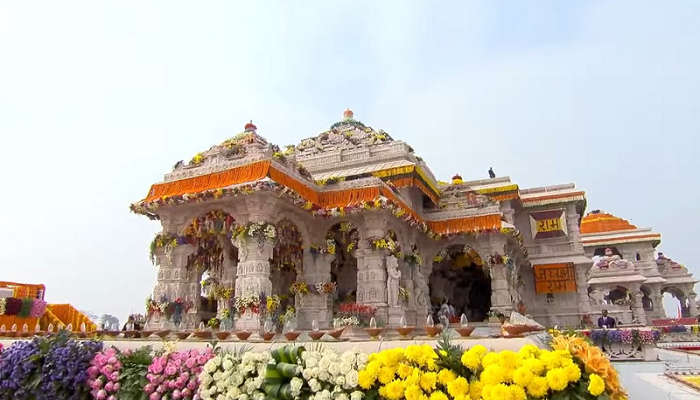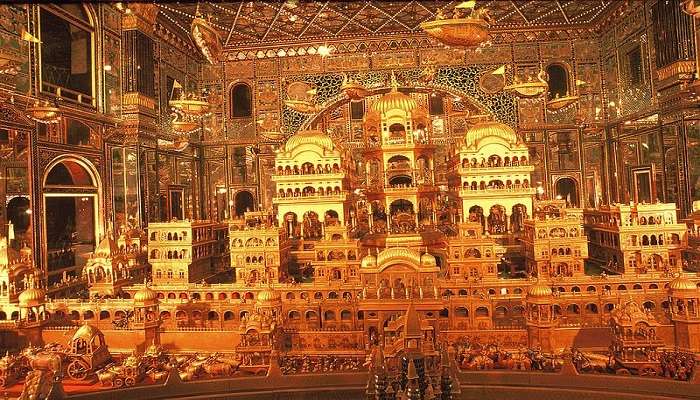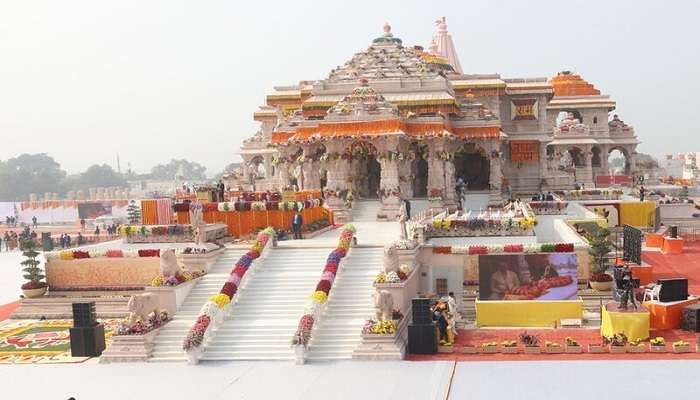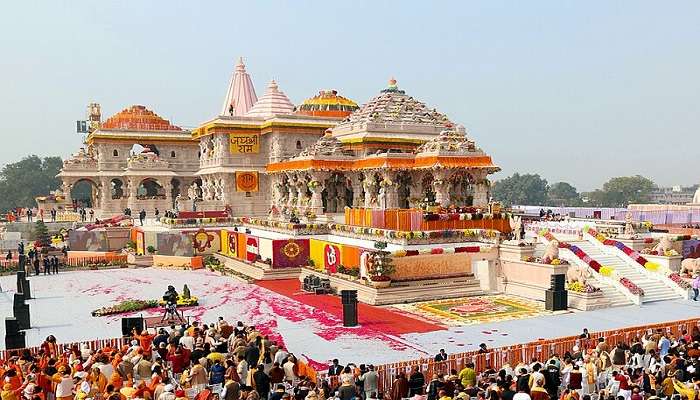A Comprehensive Travel Guide On Ayodhya Ram Mandir To Explore In 2026

Ayodhya, the historic city of Uttar Pradesh holds a lot of significance in the Hindu culture. Renowned as the birthplace of Lord Rama, Ayodhya is known for its ghats, beautiful temples and monuments. Since the establishment of the Ayodhya Ram Mandir, devotees have visited the city to get a darshan of Ram Lalla, the childhood figure of Lord Rama. As Ayodhya is tied to religious significance and is extremely important in the Hindu culture, several pilgrims visit Ayodhya around the year. Ayodhya can be a great break from the hustle and bustle of the city, offering relief among the holy chants, mantras and intense fragrance of sandalwood.
Ayodhya Ram Mandir History

Ayodhya Ram Mandir’s history dates back to the time of Lord Rama’s birth. Ram Mandir is said to be built on the site of the birthplace. Babri Masjid was built on this site after demolishing the temple in the 16th century. The mosque was later demolished in 1992 by Hindu nationalists, who claimed the site to be the birthplace of Lord Rama. This led to widespread religious and communal tensions across the country. Since then, Ayodhya has been a matter of religious and political debate among the communities. The main dispute was regarding the ownership of the land, whether it was the land where Lord Rama took birth or the land where Babri Masjid stood tall.
The Supreme Court of India later resolved the dispute in 2019, granting the land to construct the Ram Mandir and offering some land for the construction of the mosque. The Shri Ram Janmabhoomi Teerth Kshetra is a trust established by the Indian government to oversee the construction of the Ram Mandir. The Ram Lalla idol was placed in the Sanctum Sanctorum in January 2024. The temple is still midway, and a proper construction plan has been laid out, which will be followed accordingly.
Must Read: Hotels In Ayodhya
Important Facts About Ayodhya Ram Mandir

Image Credit: Prime Minister’s Office for Wikimedia Commons
Some of the major facts to know about the Ayodhya Ram Mandir facts are as follows:
- The Ram Mandir timings are from 8:00 AM-11:00 AM and 2:30 PM-5:30 PM.
- Currently, there are no Ram Mandir tickets, but they are available for free darshan. However, devotees visiting the temple must follow the rules laid out by the temple authority.
- Ram Mandir’s location is said to be exactly in Ramkot, the place of birth of Lord Rama.
- Ayodhya Ram Mandir is being built in Nagara style.
- Different zones and regions will be dedicated to the Ayodhya Ram Mandir, each with its own gates.
- Ayodhya Ram Mandir will feature a three-level tree plantation to protect the temple against dust and storms.
Essential Information

Shri Ram Janmabhoomi Teerth Kshetra oversees the guidelines for visitors visiting the temple. It is found that on average, around 1-1.5 lakh pilgrims visit the temple each day. The darshan is available for the visitors from 6:30 AM- 9:30 PM.
- During the darshan, the devotees must submit their mobile phones, purses, and footwear outside the temple premises. This helps make the darshan easier and also saves time.
- The temple authorities have strictly advised carrying flowers and garlands in the temple premises. Furthermore, specific timings are mentioned for aarti timings for which you must attain the pass to enter the temple.
- Upon attaining the entry passes, the devotees can attend the aarti. Three major aartis are conducted in the temple: Mangala aarti at 4:00 AM, Shringar Aarti at 6:15 AM and Shayan Aarti at 10:00 PM. To obtain the entry passes, the devotees will have to provide their devotee’s names, ages, Aadhar cards, city and mobile numbers.
- The Ram Janmabhoomi entry passes are free. You can obtain them only from the official website of Shri Ram Janmabhoomi Teerth Kshetra Trust. Take the Ram Mandir entry passes before heading out to the Mandir for darshan.
- No special pass is required to get a special darshan at the temple. The temple authorities have advised strictly against paying extra for the darshan. One of their posts mentioned that this might be a scam the temple authorities have no connection to.
- The temple authorities also offer wheelchairs free of cost for the people who visit the temple. These wheelchair services are available for the differently-abled and elderly, especially those willing to visit the temple.
- The wheelchair does not have a rental fee. However, a nominal fee is required for a young volunteering option.
- The temple trust offers wheelchair services only for use in the Shri Ram Janmabhoomi Mandir premises. Thus, visitors cannot use them to visit temples or Ayodhya cities.
Suggested Read: Best Places to Visit in Uttar Pradesh
Structure And Architecture

Ayodhya Ram Mandir is spread across an area of 2.7 acres of land. The entire Ram Mandir complex spans across 70 acres of land. According to the temple authorities, it will be open to darshan for up to millions of darshans once the temple is completed. The temple is 360 ft long, 235 ft wide and around 161 ft high. The Ayodhya Ram Mandir is around three times its regular height compared to the old city structures. The Ram Mandir gestures around five domes. Currently, there’s one tower, which is referred to as Garbh Griha, which is a small opening through which bright sunlight falls on the forehead of the idol of Ram Lalla.
According to the proposed model, Ram Mandir will have 366 columns with detailed carvings of around 16 idols. Each carving will showcase the divine figures and depict the history and cultural importance of different avatars of Lord Shiva, 64 Yoginis, and Dashavatars. Furthermore, it is also said that there will be 12 forms of Goddess Saraswati. The sanctum sanctorum will be kept in an octagonal form, following the Vishnu temple traditions.
The temple will be placed on a raised platform spanning three levels, featuring five mandapas situated between the sacred garvagriha and the main entrance. The three mandapas include Kudu, Rang, and Nritya, which will be placed on the side, while the Kirtan and Prarthana mandapas will be placed on the opposite ends. Each mandapa will be designed in the Nagara style, featuring shikhara and spires. According to the estimates, the tallest spire will be placed upon Garba Griha.
Further Read: Hill Stations Near Uttar Pradesh
Since the establishment of Ayodhya Ram Mandir, Ayodhya has become one of the most prominent destinations among Hindus. Ayodhya Ram Mandir should be a part of every Hindu pilgrim’s darshan. The temple is now open for darshan among the pilgrims and devotees so you can easily plan a trip to Ayodhya.
For our editorial codes of conduct and copyright disclaimer, please click here.
Cover Image Source: Narendra Modi For Wikimedia Commons
Frequently Asked Questions About Ayodhya Ram Mandir
What are the Ram Mandir Darshan timings?
The darshan timings at Ram Mandir are from 6:30 AM to 9:30 PM. In the case of a general darshan, you do not need any special entry pass. However, the entry passes will only be required in case you plan to attend an artist.
Can I explore the Ram Mandir in one day?
Yes, one day is sufficient for exploring the Ram Mandir. Your darshan of Shri Ram Lalla Sarkar should be completed within 60 to 75 minutes.
Is there a VIP pass available for Ram Mandir Darshan?
No, there is no VIP pass provision for Ram Mandir darshan. Shri Ram Janmabhoomi Teerth Kshetra, on their official X handle, had suggested no provision for darshan. If you experience any such thing, you probably have fallen victim to a scam.
Are mobile phones allowed within Ram Mandir premises?
No, mobile phones aren't allowed in the Ram Mandir premises. The devotees visiting the temple are requested to leave their mobile phones, and purses outside the mandir to save time.
What is the good time to visit the Ayodhya Ram Mandir?
It is best to visit the Ayodhya Ram Mandir in the winter months to avoid the extreme heat of Ayodhya.
People Also Read:
Mangaladevi Temple Vindhyachal Mata Mandir Jambukeswarar Temple

As a Travel Content Writer, I live to conquer the world of globetrotting with words. With my unquenchable thirst for storytelling, I believe that my words will inspire you to travel around the world’s breathtaking landscapes. As for me, I am an unapologetic selenophile, who loves to wander around in a starry night!











